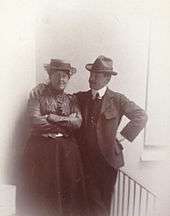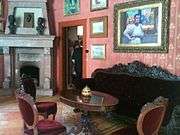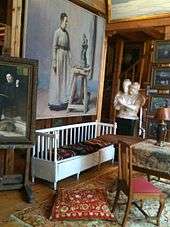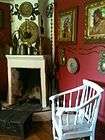William Blair Bruce
| William Blair Bruce | |
|---|---|
 | |
| Born |
October 8, 1859 Hamilton, Ontario, Canada |
| Died |
November 17, 1906 (aged 47) Stockholm, Sweden |
| Nationality | Canadian |
| Known for | Brucebo |
| Notable work | The Phantom Hunter |
| Style | Impressionism |
| Spouse(s) | Carolina Benedicks-Bruce |
| Website |
brucebostiftelsen |
William Blair Bruce (8 October 1859 – 17 November 1906) was a Canadian painter. He studied in France and became one of Canada's first impressionist painters. He lived most of his life in France and on the island of Gotland, Sweden, where he and his Swedish wife Carolina Benedicks-Bruce created the artists estate Brucebo, which was later established as a nature reserve.
Biography
Early years
William Blair Bruce was born on 8 October 1859, in Hamilton, Ontario, Canada,[1] where he grew up in Corktown and on the Mountain.[2] A plaque in Bruce Park, Hamilton marks the site of his childhood home.[3] He was the son of William Bruce, born 1833 in Scotland, who emigrated to Hamilton with his wife Janet Blair[4] in 1837.[5] Initially Bruce studied law at Hamilton Collegiate Institute,[4] but had his mind set on becoming an architect,[6] and studied for a while at the Mechanics Institute in Hamilton, in 1877. He worked for an architectural firm for the ensuing two years.[7] Members of his family were both musically and artistically inclined[4] and noticed Bruce's talent at an early age. In 1881, they sent him to Paris to study, a journey that extended over the years. He would only return to Canada on two short occasions.[7]
Paris

In Paris his classical education at Académie Julian included genre scenes and many other subjects.[1] Like many other artists of the time he wanted to experience the Parisian art scene and join in the competition to exhibit at the annual Salon in Paris.[7] He also traveled to the artist colony in Barbizon where he rented a cottage in 1882,[7] and Grez-sur-Loing where a new generation of Swedish artists, such as Carl Larsson, his wife Karin Bergöö, Bruno Liljefors and August Strindberg had formed a colony.[8] He became acquainted with Impressionism and En plein air or "outdoors painting", a style he came to prefer working with. He also became one of Canada's first impressionist painters.[9] Bruce exhibited at the Salon in 1882. His works received positive reviews but the following year his self confidence and finances deteriorated. His parents were not entirely enthusistic about his new painting style but he ignored them and began to create very large paintings. His Temps Passé was exhibited at the 1884 Salon[9] although despite this success he remained in financial difficulties.[4] Bruce subsequently suffered a nervous breakdown and hastily returned to Canada for the first time.[4] To compound his problems, the steamship Brooklyn, carrying about 200 of his works, sank outside Anticosti Island in the Gulf of Saint Lawrence on 8 November 1885.[4][7]
In the summer of 1885, Bruce had met the Swedish sculptor Carolina Benedicks in France. They fell in love and when Bruce returned to Canada, she made a surprise visit accompanied by her uncle, to persuade him to return to Paris. They were engaged in the autumn of 1886, and returned to Europe in 1887.[7]
Return to Europe

Bruce returned to France a bolder artist. He painted The Phantom Hunter in 1888, which became an instant success at the Salon and marked the peak of his carrier.[9] He and Benedicks married at the British embassy in Stockholm on 5 December the same year.[10][4] She provided energy and stability for Bruce throughout his life and also became his favorite model.[4]
In May 1889, the couple returned to Grez and Bruce wrote to his mother that "Grèz [sic] is a great improvement on Barbizon, quite a different country in fact". A month later, Bruce also sold some paintings to the American artist Walter Gay, who was visiting Grez at the time. Bruce and Benedicks-Bruce continued to make annual visits to Grez up until 1894. They rented a small house, which had previously been the home of Carl Larsson and his wife Karin. It was here that Bruce painted his Open-Air Studio (now in the National Museum of Fine Arts, Stockholm). It is a view from their home in Grez, picturing Benedicks-Bruce doing an etching out-doors behind a sun screen. In 1895, the couple made a brief journey to Hamilton in Canada,[11] where Bruce painted on the Six Nations Reserve.[4] Throughout the 1890s, they led a bohemian life, travelling to Capri, Italy and Sweden where they took a liking to Gotland and its light.[7]
In 1900–06, the couple created a summer home called Brucebo (Swedish for: "The house where Bruce lives") on Gotland.[11] Here, Bruce painted, did some amateur archaeology and socialized with the locals, while Benedicks-Bruce worked with sculptures and etchings as well as tended the garden and the many animals she had gathered at Brucebo.[6][7]
Bruce died suddenly on 17 November 1906 in Stockholm at the age of 47,[1] and Benedicks-Bruce settled down permanently at Brucebo.[10] After Bruce's death, a commemorative exhibition of 122 of his works was held in Paris in 1907.[4] Carolina donated 29 of his paintings to the City of Hamilton. This donation became the foundation of the Art Gallery of Hamilton that opened in 1914.[2] Even though Bruce enjoyed a good reputation towards the end of his life with 15 participations at the Salon, exhibitions in London, Toronto, Stockholm, Buffalo and came to influence many young artists in Canada,[12] he remains as of 2015 relatively unknown. A large part of his production can be seen at Brucebo, which is now a museum managed by the Brucebo Foundation.[4]
Benedicks-Bruce stayed at Brucebo until her death on 16 February 1935.[13]
Brucebo
Originally used as a summer house by Bruce and his wife, they rebuilt and extended Brucebo in 1900–06 into their permanent home and studio.[12] In 2009, the estate was converted into an art museum. In connection to this, a shooting occurred at the main house.[14] The museum and the estate are managed by the Brucebo Foundation.[6] The foundation also grants scholarship to younger Canadian artists.[15] In 1970, the 35 ha (0.35 km2) Brucebo estate was established as a nature reserve.[16]
Gallery
 Brucebo artist's home, room with Bruce's portrait of his wife
Brucebo artist's home, room with Bruce's portrait of his wife The south part of the studio in Brucebo, Benedicks-Bruce's L'obsède (left, back), Michel Angelo and bust of Bruce (right, front)
The south part of the studio in Brucebo, Benedicks-Bruce's L'obsède (left, back), Michel Angelo and bust of Bruce (right, front) The studio in Brucebo, Bruce's self portrait (left) and full figure portrait of his wife
The studio in Brucebo, Bruce's self portrait (left) and full figure portrait of his wife The "Indian room" at Brucebo with paintings from the Six Nations Reserve
The "Indian room" at Brucebo with paintings from the Six Nations Reserve
See also
References
- 1 2 3 "William Blair Bruce". www.thecanadianencyclopedia.ca. Historica Canada. Retrieved 12 July 2015.
- 1 2 Haggo, Regina. "Hamilton's most famous painter comes home". www.thespec.com. The Hamilton Spectator. Retrieved 12 July 2015.
- ↑ Brown, Alan L. "William Blair Bruce 1859-1906". www.ontarioplaques.com. Ontario's Historical Plaques. Retrieved 12 July 2015.
- 1 2 3 4 5 6 7 8 9 10 11 "Bruce, William Blair". www.biographi.ca. University of Toronto. Retrieved 13 July 2015.
- ↑ Lundgren, Jan (January 2010). "Benedicks– Bruce Chronology 1856 – 1935". www.bruceboscholarshipsc.ipage.com. Brucebo Scholarships. Retrieved 12 July 2015.
- 1 2 3 Svännel, Jessica. "Vårdprogram för trädgården på Brucebo" (PDF). www.jessicasvannel.se. Swedish University of Agricultural Sciences. Retrieved 11 July 2015.
- 1 2 3 4 5 6 7 8 Lundgren, Jan O. Bill Manson, ed. "The Bruce-Benedicks Saga and the Birth of the AGH". www.artgalleryofhamilton.com. Art Gallery of Hamilton. Retrieved 11 July 2015.
- ↑ "Venez à Grez! Venez à Grez!" [Come to Grez! Come to Grez!]. www.artistes-grezsurloing.fr (in French). Associations de Grez-sur-Loing. Retrieved 13 July 2015.
- 1 2 3 Jeffrey, Robyn (25 August 2014). "Into The Light: The Paintings of William Blair Bruce at the Art Gallery of Hamilton". www.ngcmagazine.ca. National Gallery of Canada. Retrieved 12 July 2015.
- 1 2 Mörner, Stellan G. (1922). "Carolina M Benedicks-Bruce". Svenskt biografiskt lexikon (in Swedish). 3. National Archives of Sweden. p. 162. Retrieved 12 July 2015.
- 1 2 Salus, Carol (2004). Out of Context: American Artists Abroad (8 ed.). Westport,CT: Greenwood Publishing Group. p. 55. ISBN 0-313-31649-X.
- 1 2 Molin, Maria (17 July 2014). "Att fånga Brucebos ljus" [To capture Brucebo's light]. www.gotland.net (in Swedish). Gotlands Media AB. Retrieved 12 July 2015.
- ↑ Westholm, Gun. "Carolina Benedicks Bruce". www.gotland.net (in Swedish). Gotlands Media AB. Retrieved 12 July 2015.
- ↑ Leino, Per (2 December 2008). "All ilska riktades mot ordföranden" [All anger was directed at the chairman]. www.helagotland.se (in Swedish). Helagotland.se. Retrieved 13 July 2015.
- ↑ "Brucebo and W.B. Bruce Fine Art Scholarships for Canadian Artists". www.swedenabroad.com. Embassy of Sweden, Ottawa. Retrieved 14 July 2015.
- ↑ "En William Blair kommer hem" [A William Blair comes home]. www.lansstyrelsen.se (in Swedish). The County Administrative Boards of Gotland County. 8 April 2011. Retrieved 14 July 2015.
Further reading
- Bruce, William Blair; Murray, Joan (1982). Letters home, 1859–1906: the letters of William Blair Bruce. Penumbra Press. ISBN 978-0-920806-36-4.
External links
| Wikimedia Commons has media related to William Blair Bruce. |
- Maps, pictures and a presentation of Brucebo (in Swedish)